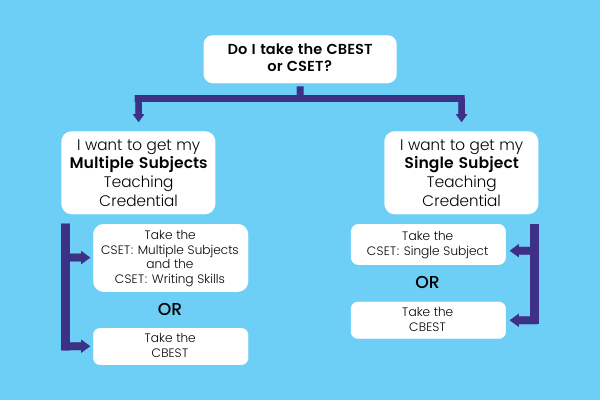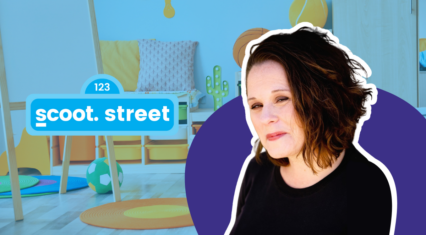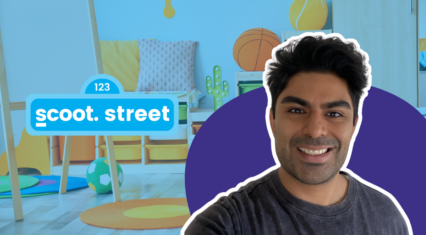Search
Get started
Log into your referral dashboard
Confused by the CBEST and CSET and which test you should take? Both exams are part of the process of becoming a teacher in California and were developed by the California Commission on Teacher Credentialing (CTC).
If you want to get your teaching credential, you’ll need to know the difference between the CBEST and CSET exams and will most likely have to take one of the tests. Luckily, we have all the answers on what these exams are, how to prepare and how to pass!
1) What is the basic skills requirement?
In order to work in a California public school, you must verify basic skills proficiency before getting a credential, certificate or permit. There are several ways to meet this requirement:
- Pass the CBEST
- Pass the CSET
- Pass the CSU Early Assessment Program or the CSU Placement Examinations
- Get a qualifying score on the SAT or the ACT
- Get a score of 3 or higher on the College Board AP English exam, AP Calculus exam or the AP Statistics exam
- Pass a basic skills examination from another state
- Meet the basic skills requirement by coursework (LINK TO COURSEWORK SECTION)
- Meet the basic skills requirement by coursework and exam
This blog will cover how to fulfill the basic skills requirement through the CBEST or CSET. However, if you can meet the requirement without the exams, then you don’t have to take them!
2) What is the CBEST test?
CBEST stands for the California Basic Educational Skills Test. As a teacher, you need to demonstrate that you have a good grasp of fundamental subjects, regardless of the grade level you’re going to teach.
Those fundamental subjects are:
- Mathematics
- Reading in English
- Writing in English
Since the CBEST exam only tests your knowledge of these subjects, you might have to take other tests showing your ability to teach other subjects.
Once you take and pass the CBEST, you’ll be eligible to earn your Multiple Subject Teaching Credential as well as your Single Subject Teaching Credential!
3) What is the CSET test?
CSET stands for the California Subject Examinations for Teachers. This exam measures your competency in certain subject areas.
The CSET has multiple categories and each category tests the skills required to teach a specific subject. You can pick and choose which ones you want to take.
The 5 categories are:
- Multiple Subjects: This test is made up of 3 subtests covering multiple subjects, like the name suggests.
- Single Subject: There are many subject areas you can choose to test in. If you pass the exam, you’ll be allowed to teach that particular subject in middle and secondary schools.
- Writing Skills: Required if you do not pass all three sections of the CBEST or all three subtests of the CSET: Multiple Subjects exam.
- Preliminary Education Technology: Used for evaluating the skills required for using computers
- Languages Other Than English(LOTE): Required to teach a language other than English
If you want to teach several subjects, you will need to take and pass the CSET: Multiple Subjects test or the corresponding CSET: Single Subject tests. Once you pass your selected exams, you’ll be able to earn your Multiple Subject Teaching Credential which allows preschool and K-12 educators to teach most subjects.
If you just want to teach one subject, you only need to take and pass the CSET: Single Subject test. Once you pass the CSET: Single Subjects test in the subject matter you want to teach, you’ll be able to earn your Single Subject Teaching Credential and teach in preschools and K-12 grades.
People who have passed the CSET vary in their evaluation of the test’s difficulty. Some say it’s a difficult test while others claim it’s not. But studying effectively and efficiently will ensure that the test is not too difficult for you.
4) CBEST vs. CSET: Which exam do I need to take?
Now that you know the differences between the two exams, you’ll need to figure out which one you’ll take to become a teacher in California.
What if I took only the CSET?
If you want to get your Multiple Subjects Teaching Credential, you’ll need to take and pass the CSET: Multiple Subjects test as well as the CSET: Writing Skills.
If you want to get your Single Subject Teaching Credential, you’ll need to only take and pass the CSET: Single Subject test.
What if I took only the CBEST?
If you only take the CBEST exam, you’ll be eligible to apply for both the Multiple Subject Teaching Credential and Single Subject Teaching Credential.
As noted previously, there are three subtests on the CBEST. Luckily, you don’t have to pass all three sections in the same testing session, nor do you have to even take all three at the same time.
So, which option should you choose?
Passing either the CBEST or the CSET: Multiple Subjects and CSET: Writing Skills will ensure that you cover the basic skills requirement of California teaching credentials so, ultimately, the choice is yours.
However, if you’re planning to take any other categories of the CSET such as:
- Preliminary Education Technology
- Languages Other Than English
Then you’ll have to also plan to take the CBEST as well.
One thing to note is that a benefit of taking the CSET math compared to the CBEST math, is that the CSET allows the use of a basic calculator while the CBEST does not. Keep in mind that the CSET combines science with the math section, so if you feel confident in your math and science abilities, you might find the CSET easier.
Now that you know this, you can make the decision that is right for you!
5) Why do I need to take an exam?
We get it, standardized tests aren’t for everyone! But in order for you to become a teacher in the state of California, you need to prove that you have mastery over essential subject matters.
Passing either the CSET or CBEST exams shows that you have what it takes to be a Californian teacher!
What about using your coursework to fulfill the basic skills requirement? Keep reading to see if your college-level classes can help you meet this!
6) Other ways to fulfill the basic skills requirement – new California bill
For the longest time, the only way to check off the basic skills requirement for all teachers was to take and pass either the CBEST or CSET exams.
However, Governor Newsom signed the TK-12 Education Trailer Bill (AB 130) in July of 2021. This bill gives aspiring teachers new ways to meet the basic skills requirement.
Now, you can prove competency by completing full-credit, college-level coursework with a grade of a B or higher in the following subject areas:
- Reading (including courses in critical thinking, literature, philosophy, reading, rhetoric or textual analysis)
- Writing (including courses in composition, English, rhetoric, written communications or writing)
- Mathematics (including courses in geometry, mathematics, quantitative reasoning or statistics)
- Classes from closely related fields may also be used to satisfy this requirement
This new measure also allows incoming teachers to meet the CSET requirements if they have received a Bachelor’s degree in the subject they will teach.
7) How to pass the CBEST? How to pass the CSET?
As you take this next step toward your teaching career, you’ll need to know what a passing grade is for these exams. Keeping these numbers in mind will help you set and reach goals during your study process.
CBEST passing scores
Each section of the CBEST exam is scaled from 20 to 80 points, with the reading subtest and mathematics subtest being scored based on how many multiple-choice questions you get right:
- 61-80: You answered most of the questions correctly
- 41-60: You answered many of the questions correctly
- 31-40: You answered some of the questions correctly
- 20-30: You answered few or none of the questions correctly
Luckily, wrong answers are not counted against you on the test so you should make sure to fill in all the answers instead of leaving anything blank. Hopefully, this makes test day a little less stressful!
The written section
Since the written section of this exam is scaled based on the quality of 2 essays you write, it’s scored a little differently than the other sections. Your essays will be scored from 1 to 4, with 1 being the lowest score and 4 being the highest:
- 4: Your writing is well-formed with effective communication
- 3: Your writing is adequate with some communication
- 2: Your writing is partially-formed with an attempt at communication
- 1: Your writing is inadequately-formed with little to no communication
These essays are scored twice, so an essay’s score can range from 2 to 8. The scores of these essays will then be added together, so you can earn between 4 to 16 points on this section. Finally, this grade will be converted to a 20 to 80 point scale and added to your final CBEST score.
What is a passing score?
In all, you must receive a total score of at least 123 in order to pass the CBEST exam, with no section’s score dropping below a 37. You should aim for at least a 41 on each section, but a score between 37 and 41 is acceptable if you make up for the loss of points in another section.
CSET passing scores
To pass a CSET subtest, you must earn a passing rate of 70% or better. Like with the CBEST, wrong answers won’t count against you so it’s best to just guess instead of leaving an answer blank.
The CSET subtests usually have between 30 to 50 multiple choice questions, however, some tests can have up to 100 questions. The number of questions you’ll get will vary depending on the subtest you take.
8) How do I study for the CBEST and CSET exams?
Just like with any standardized testing, you’ll need to study if you want to pass.
Take a practice test
To understand where you’re starting from, you should take a practice test to assess your knowledge.
Test-guide.com has practice tests that you can take and review for free:
Remember: You need to simulate test-day conditions. Sit in a quiet place, remove any distractions, set your phone to Do Not Disturb, and only check the answers when you’ve finished taking the entire test. Treat these practice test questions as if they were the real deal!
Once you’ve taken and scored your practice exam, you can create a study plan for yourself.
Make a study plan
Now that you’ve evaluated your test readiness, you can come up with a study plan. Study plans are extremely helpful for keeping you on track and holding you accountable.
If you’ve been out of school for a while or are a little rusty on the subjects, you should plan to study for about an hour a day for a few weeks to a few months. For those who feel confident that they have a good grasp of the subject matters, you may study for less time.
Study plans will look different from person to person so don’t compare yourself to others as you’re preparing for these exams.
Be realistic
You don’t want to create a study plan that has you burnt out within the first week of studying.
A few questions you should ask yourself are:
- What days of the week can you study? If you have no free time during the weekend, don’t say that you’ll study for 2 hours during that time. Instead, find times that work best with your current schedule.
- What time of day works best for you? If you know that you don’t like waking up early in the mornings, schedule your study time to be for the afternoons or evenings. And if you’re a morning bird, set your study time for the mornings!
- How much do you need to study? This answer depends on how you performed on your practice tests. If you have a lot to review, you’ll need to allocate enough time to study everything.
- How do you prefer to learn? Can you study virtually or do you need a physical textbook in front of you? Do you need to make flashcards or do virtual flashcards work for you? These are some things to consider as you begin your studies.
Once you have a good idea of a schedule that works for you and won’t burn you out, you should write down your study plan. Put it into your calendar or write it in your agenda – just make sure you can easily reference it whenever.
Things to include in your study plan
You should be scheduling practice tests once every 2 weeks or once a month. Taking practice tests will help you track how well you’re doing and how much more you need to study.
Write down your scores every time so you can visibly see your progress!
Also, you don’t have to take a full practice exam every time. You can take one or two sections at a time and review them fully in the following days.
- Be sure to include this review time into your study plan!
- For questions you got wrong, look over your answer and figure out why you chose it. Then, look at the right answer and find out why that one is correct and why the answer you chose is wrong. Don’t move on until you fully understand the correct answer and the mistake you made.
Next, include a tentative test date! Not only should you have a goal of getting a passing grade, you should also set a date that you plan to take the test.
Finally, make sure to include breaks in your study plan. Don’t study every single day or you risk burn out.
Maybe you don’t study over the weekends, or maybe you don’t study on Mondays and Thursdays – it all depends on you. Choose what works for you and create a sustainable study plan.
9) CBEST registration and CSET registration
You can quickly and easily register for either test on the CTC website.
CBEST registration
Online registration for the CBEST is available 24 hours a day and 7 days a week.
Follow these steps to ensure a smooth signup:
- Sign into your CTC Exams account or, if you don’t have an account, create one.
- Answer the question verifying that you’re registering yourself for the exam.
- Select the option “California Basic Education Skills Test (CBEST)” on the Program Selection page.
- Decide if you want to take a computer-based test or a paper-based test. If you want more CBEST test date options, select the computer-based test.
- Alternative testing arrangements are on the next page. If you don’t need them, select “No”.
- You’ll be notified on the next page that you have a year to schedule your test from the time that you’re registering.
- Most applicants will not have to choose “Institution to receive test results” on the next page. You should just have your scores mailed to you.
- Answer questions about yourself.
- Review your registration, add to your cart and pay.
- Once you sign the agreement form on the next page, you’ll be registered for the CBEST exam!
After you’ve registered, you can schedule your test and you’re set!
CSET registration
Online registration for the CSET is available 24 hours a day and 7 days a week.
Follow these steps to ensure a smooth signup:
- Visit the CTC Exams website and navigate to the drop-down menu that says “Select an assessment…”.
- Select the CSET test you want to take and hit “Go”.
- Sign into your CTC Exams account or, if you don’t have an account, create one.
- Answer the question verifying that you’re registering yourself for the exam.
- Select the option “California Subject Examinations for Teachers (CSET)” on the Program Selection page.
- Decide if you want to take a computer-based test or a paper-based test. If you want more CSET test date options, select the computer-based test.
- Alternative testing arrangements are on the next page. If you don’t need them, select “No”.
- You’ll be notified on the next page that you have a year to schedule your test from the time that you’re registering.
- Most applicants will not have to choose “Institution to receive test results” on the next page. You should just have your scores mailed to you.
- Answer questions about yourself.
- Review your registration, add to your cart and pay.
- Once you sign the agreement form on the next page, you’ll be registered for the CSET exam!
After you’ve registered, you can schedule your test and you’re set!
10) Resources to study for the CBEST and CSET exams
Now that you know everything about these exams, all you have to do now is start preparing!
Luckily, there are many free CSET and CBEST prep online to help you.
- Study.com has many free test prep study guides to help you as you begin studying.
- Test-guide.com has plenty of free practice tests along with the correct answer choices at the end.
- The California Educator Credentialing Assessments also has a lot of free resources to choose from:
- CBEST test prep materials
- CSET test prep materials – under the drop-down menu titled “California Subject Examinations for Teachers (CSET)
You’re ready!
Now, you’re ready to tackle and pass the CSET and CBEST exams!
Once you pass either exam (because we know you will!), you will have fulfilled the basic skills requirement of the California teaching credentials and you can get the rest of your application together. You can also become a substitute teacher if you pass either the CBEST or the CSET: Multiple Subjects and CSET: Writing Skills exams!
Thinking about joining a teacher credentialing program?
Did you know that many teacher credentialing programs require that you pass either one or both of these exams in order to begin your credentialing journey?
Luckily, TeachStart doesn’t require that! As long as you meet the basic skills requirement, you’re eligible to join.
There might be times that studying gets difficult but keep working hard, stick to your study plan and you’ll soon see the results you want. All that time studying will ensure that you will earn a passing grade on whichever test you decide to take!






![How to write a strong substitute note [+free template!]](https://scoot.education/wp-content/uploads/2022/05/thank-you-426x235.png)


